radiator MAZDA MODEL 3 4-DOOR 2005 Owners Manual
[x] Cancel search | Manufacturer: MAZDA, Model Year: 2005, Model line: MODEL 3 4-DOOR, Model: MAZDA MODEL 3 4-DOOR 2005Pages: 378, PDF Size: 5.32 MB
Page 111 of 378
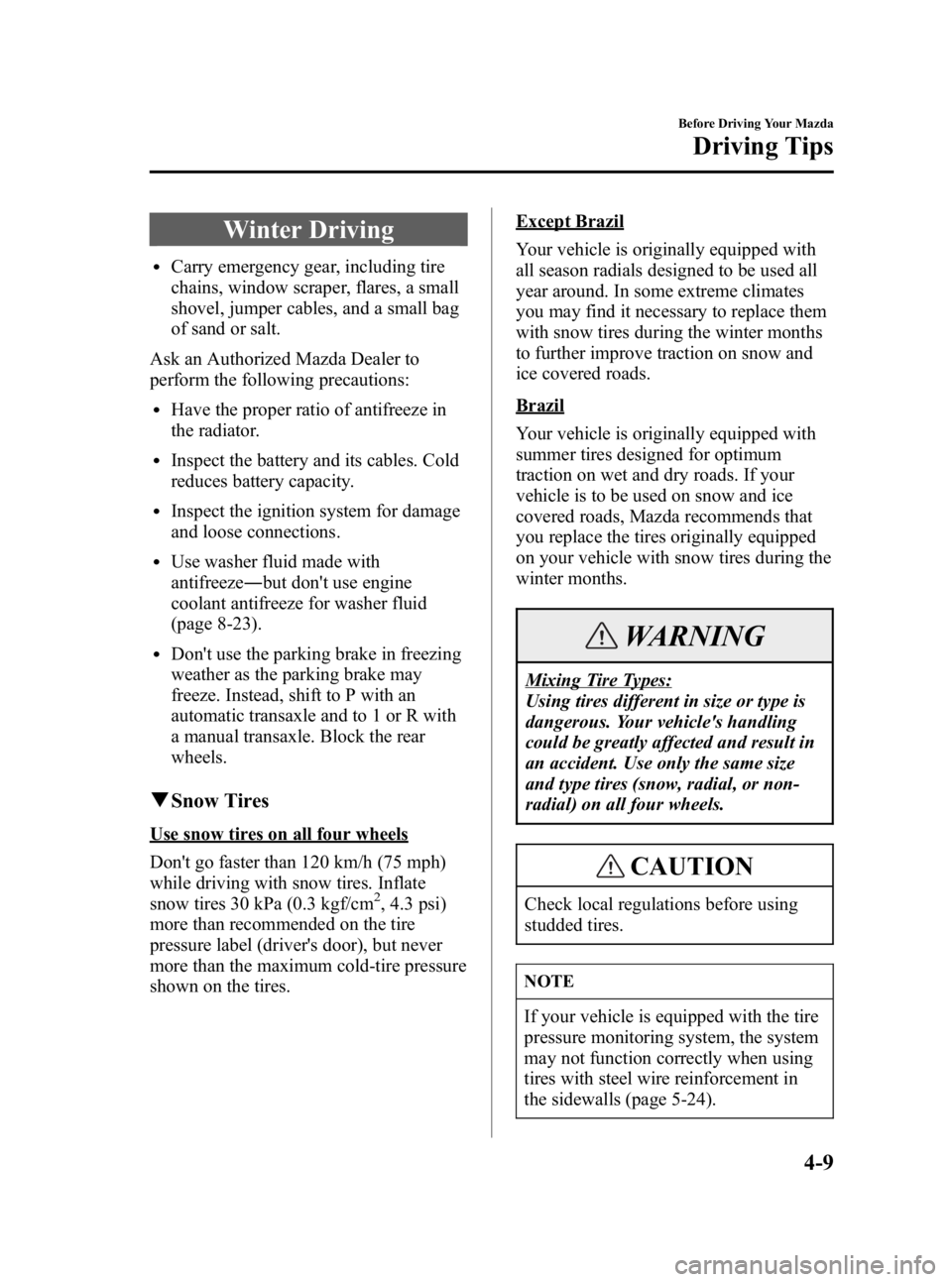
Black plate (111,1)
Winter Driving
lCarry emergency gear, including tire
chains, window scraper, flares, a small
shovel, jumper cables, and a small bag
of sand or salt.
Ask an Authorized Mazda Dealer to
perform the following precautions:
lHave the proper ratio of antifreeze in
the radiator.
lInspect the battery and its cables. Cold
reduces battery capacity.
lInspect the ignition system for damage
and loose connections.
lUse washer fluid made with
antifreeze ―but don't use engine
coolant antifreeze for washer fluid
(page 8-23).
lDon't use the parking brake in freezing
weather as the parking brake may
freeze. Instead, shift to P with an
automatic transaxle and to 1 or R with
a manual transaxle. Block the rear
wheels.
q Snow Tires
Use snow tires on all four wheels
Don't go faster than 120 km/h (75 mph)
while driving with snow tires. Inflate
snow tires 30 kPa (0.3 kgf/cm
2, 4.3 psi)
more than recommended on the tire
pressure label (driver's door), but never
more than the maximum cold-tire pressure
shown on the tires.
Except Brazil
Your vehicle is originally equipped with
all season radials designed to be used all
year around. In some extreme climates
you may find it necessary to replace them
with snow tires during the winter months
to further improve traction on snow and
ice covered roads.
Brazil
Your vehicle is originally equipped with
summer tires designed for optimum
traction on wet and dry roads. If your
vehicle is to be used on snow and ice
covered roads, Mazda recommends that
you replace the tires originally equipped
on your vehicle with snow tires during the
winter months.
WARNING
Mixing Tire Types:
Using tires different in size or type is
dangerous. Your vehicle's handling
could be greatly affected and result in
an accident. Use only the same size
and type tires (snow, radial, or non-
radial) on all four wheels.
CAUTION
Check local regulations before using
studded tires.
NOTE
If your vehicle is equipped with the tire
pressure monitoring system, the system
may not function correctly when using
tires with steel wire reinforcement in
the sidewalls (page 5-24).
Before Driving Your Mazda
Driving Tips
4-9
Mazda3_8T96-EA-04J_Edition3 Page111
Wednesday, May 11 2005 3:37 PM
Form No.8T96-EA-04J
Page 163 of 378
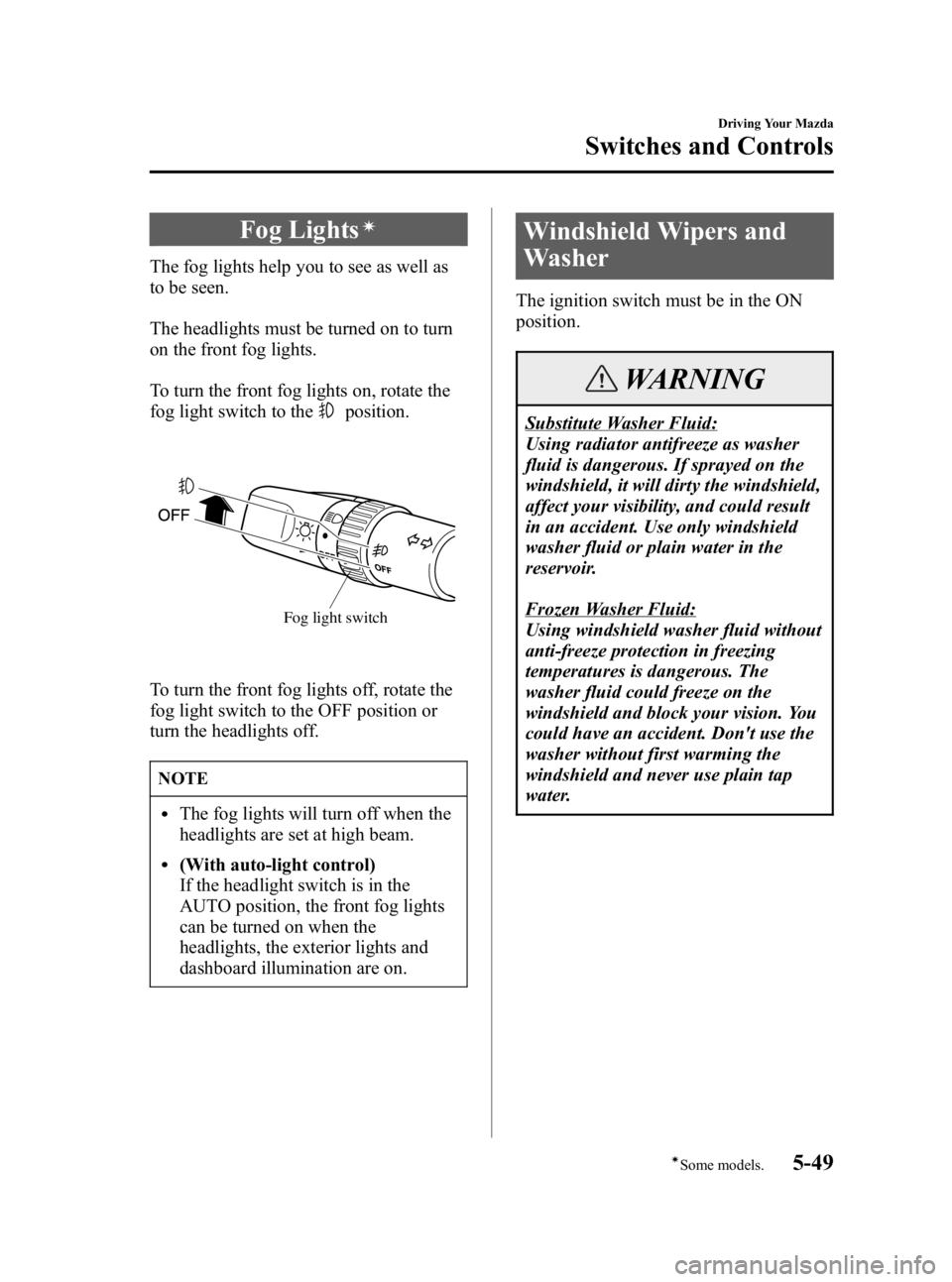
Black plate (163,1)
Fog Lightsí
The fog lights help you to see as well as
to be seen.
The headlights must be turned on to turn
on the front fog lights.
To turn the front fog lights on, rotate the
fog light switch to the
position.
Fog light switch
To turn the front fog lights off, rotate the
fog light switch to the OFF position or
turn the headlights off.
NOTE
lThe fog lights will turn off when the
headlights are set at high beam.
l(With auto-light control)
If the headlight switch is in the
AUTO position, the front fog lights
can be turned on when the
headlights, the exterior lights and
dashboard illumination are on.
Windshield Wipers and
Washer
The ignition switch must be in the ON
position.
WARNING
Substitute Washer Fluid:
Using radiator antifreeze as washer
fluid is dangerous. If sprayed on the
windshield, it will dirty the windshield,
affect your visibility, and could result
in an accident. Use only windshield
washer fluid or plain water in the
reservoir.
Frozen Washer Fluid:
Using windshield washer fluid without
anti-freeze protection in freezing
temperatures is dangerous. The
washer fluid could freeze on the
windshield and block your vision. You
could have an accident. Don't use the
washer without first warming the
windshield and never use plain tap
water.
Driving Your Mazda
Switches and Controls
5-49íSome models.
Mazda3_8T96-EA-04J_Edition3 Page163
Wednesday, May 11 2005 3:37 PM
Form No.8T96-EA-04J
Page 232 of 378
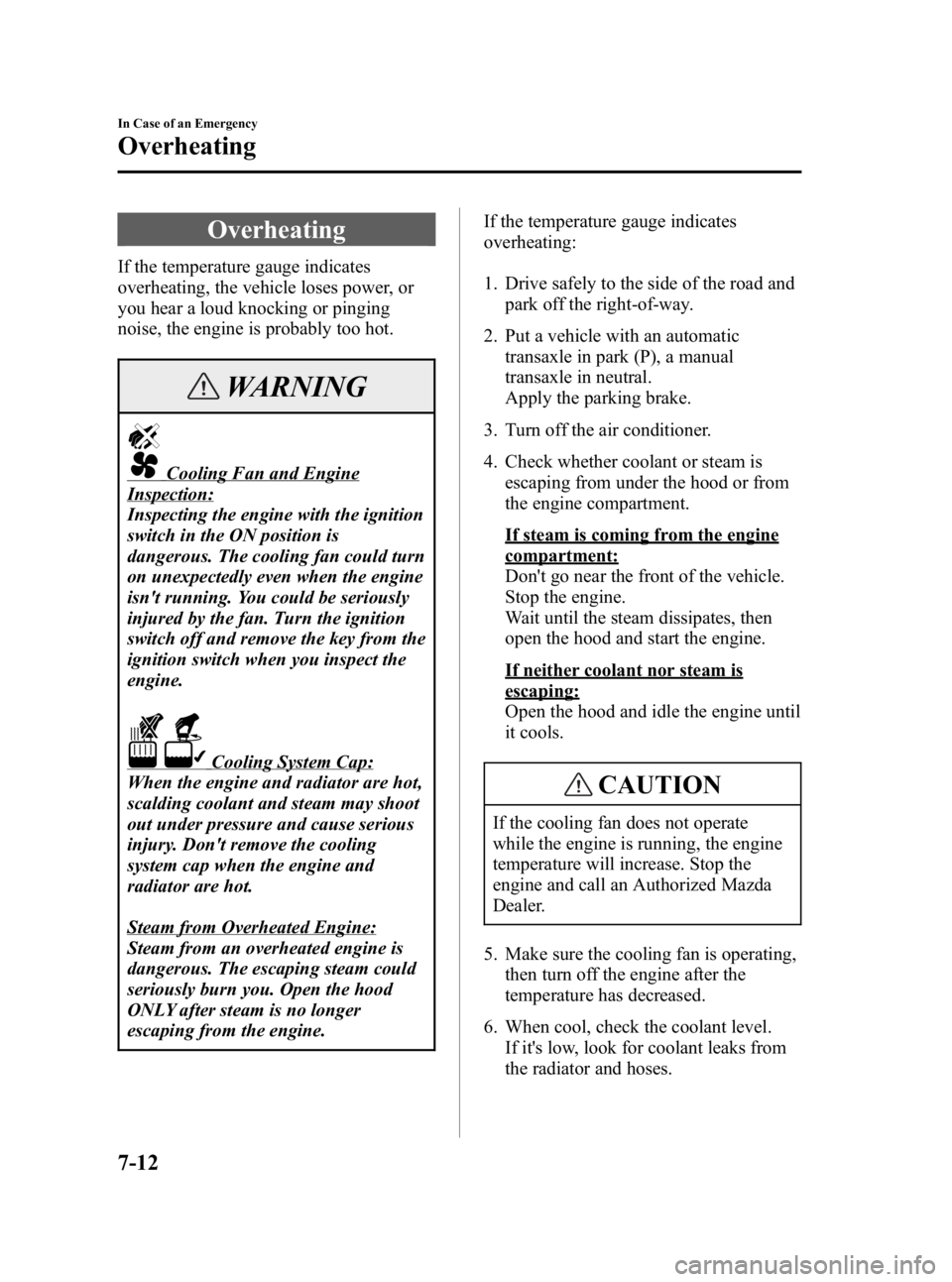
Black plate (232,1)
Overheating
If the temperature gauge indicates
overheating, the vehicle loses power, or
you hear a loud knocking or pinging
noise, the engine is probably too hot.
WARNING
Cooling Fan and Engine
Inspection:
Inspecting the engine with the ignition
switch in the ON position is
dangerous. The cooling fan could turn
on unexpectedly even when the engine
isn't running. You could be seriously
injured by the fan. Turn the ignition
switch off and remove the key from the
ignition switch when you inspect the
engine.
Cooling System Cap:
When the engine and radiator are hot,
scalding coolant and steam may shoot
out under pressure and cause serious
injury. Don't remove the cooling
system cap when the engine and
radiator are hot.
Steam from Overheated Engine:
Steam from an overheated engine is
dangerous. The escaping steam could
seriously burn you. Open the hood
ONLY after steam is no longer
escaping from the engine. If the temperature gauge indicates
overheating:
1. Drive safely to the side of the road and
park off the right-of-way.
2. Put a vehicle with an automatic transaxle in park (P), a manual
transaxle in neutral.
Apply the parking brake.
3. Turn off the air conditioner.
4. Check whether coolant or steam is escaping from under the hood or from
the engine compartment.
If steam is coming from the engine
compartment:
Don't go near the front of the vehicle.
Stop the engine.
Wait until the steam dissipates, then
open the hood and start the engine.
If neither coolant nor steam is
escaping:
Open the hood and idle the engine until
it cools.
CAUTION
If the cooling fan does not operate
while the engine is running, the engine
temperature will increase. Stop the
engine and call an Authorized Mazda
Dealer.
5. Make sure the cooling fan is operating, then turn off the engine after the
temperature has decreased.
6. When cool, check the coolant level. If it's low, look for coolant leaks from
the radiator and hoses.
7-12
In Case of an Emergency
Overheating
Mazda3_8T96-EA-04J_Edition3 Page232
Wednesday, May 11 2005 3:38 PM
Form No.8T96-EA-04J
Page 247 of 378
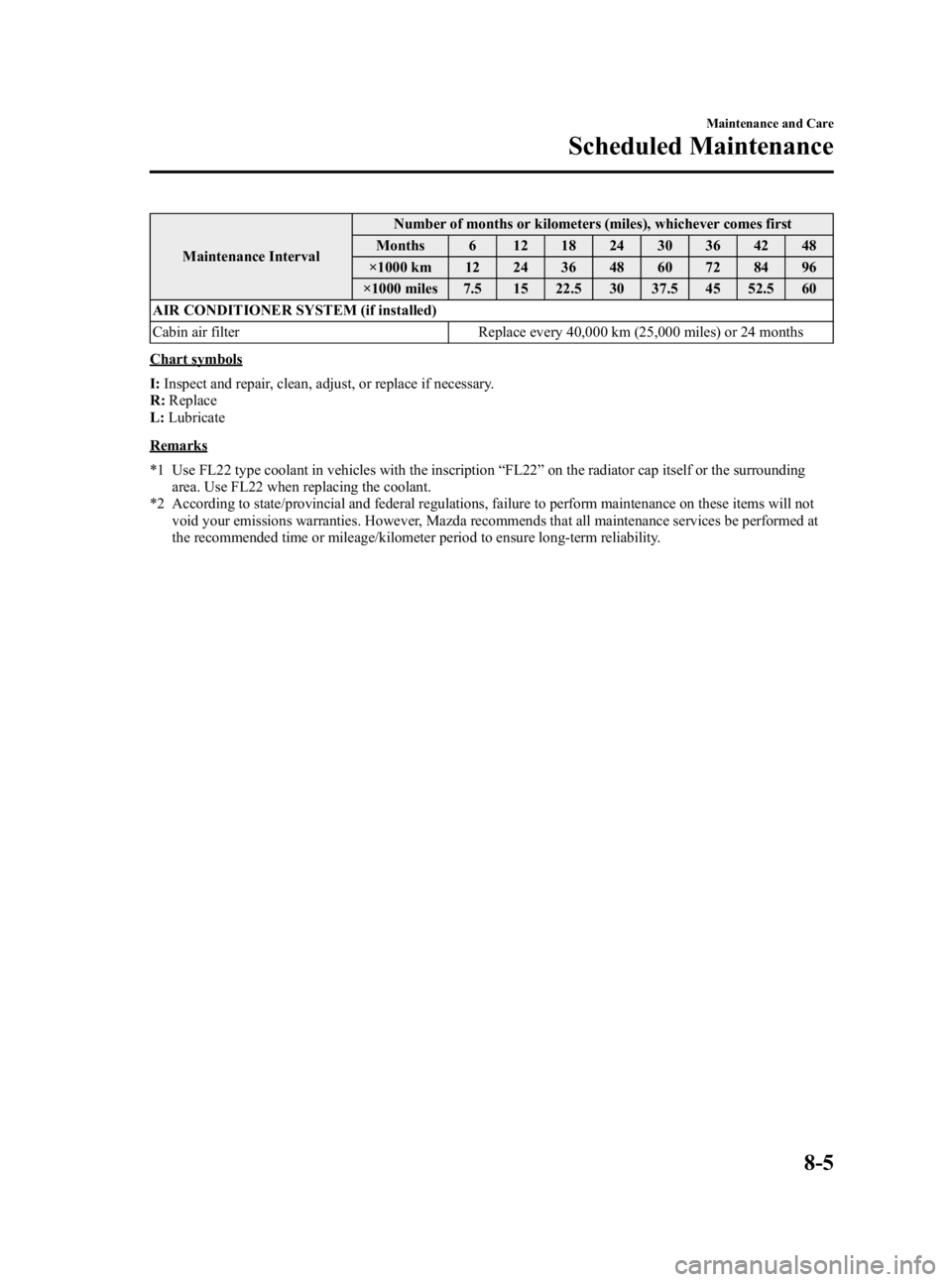
Black plate (247,1)
Maintenance IntervalNumber of months or kilometers (miles), whichever comes first
Months 6 12 18 24 30 36 42 48
×1000 km 12 24 36 48 60 72 84 96
×1000 miles 7.5 15 22.5 30 37.5 45 52.5 60
AIR CONDITIONER SYSTEM (if installed)
Cabin air filter Replace every 40,000 km (25,000 miles) or 24 months
Chart symbols
I: Inspect and repair, clean, adjust, or replace if necessary.
R: Replace
L: Lubricate
Remarks
*1 Use FL22 type coolant in vehicles with the inscription “FL22 ”on the radiator cap itself or the surrounding
area. Use FL22 when replacing the coolant.
*2 According to state/provincial and federal regulations, failure to perform maintenance on these items will not void your emissions warranties. However, Mazda recommends that all maintenance services be performed at
the recommended time or mileage/kilometer period to ensure long-term reliability.
Maintenance and Care
Scheduled Maintenance
8-5
Mazda3_8T96-EA-04J_Edition3 Page247
Wednesday, May 11 2005 3:39 PM
Form No.8T96-EA-04J
Page 249 of 378
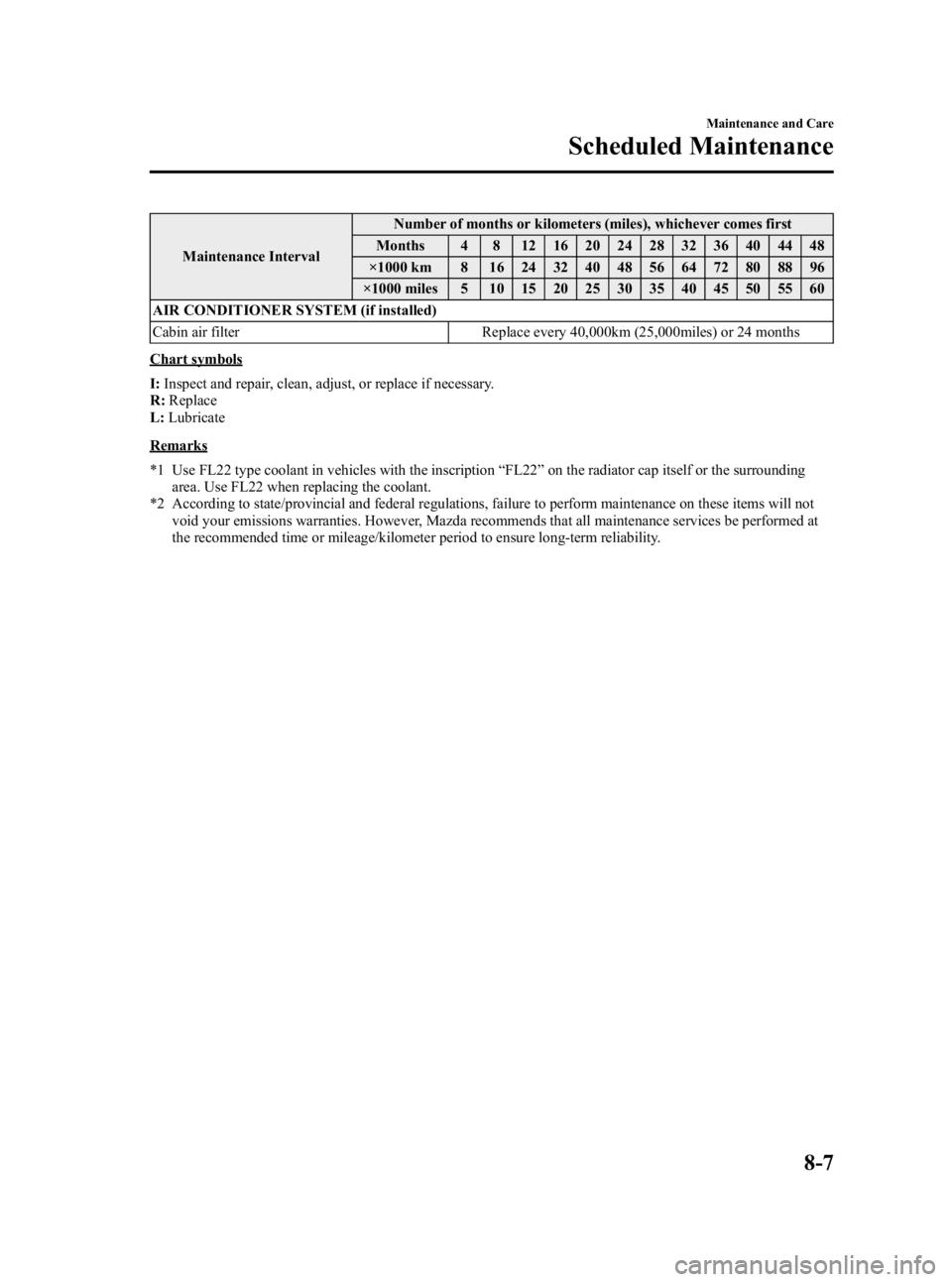
Black plate (249,1)
Maintenance IntervalNumber of months or kilometers (miles), whichever comes first
Months 4 8 12 16 20 24 28 32 36 40 44 48
×1000 km 8 16 24 32 40 48 56 64 72 80 88 96
×1000 miles 5 10 15 20 25 30 35 40 45 50 55 60
AIR CONDITIONER SYSTEM (if installed)
Cabin air filter Replace every 40,000km (25,000miles) or 24 months
Chart symbols
I: Inspect and repair, clean, adjust, or replace if necessary.
R: Replace
L: Lubricate
Remarks
*1 Use FL22 type coolant in vehicles with the inscription “FL22 ”on the radiator cap itself or the surrounding
area. Use FL22 when replacing the coolant.
*2 According to state/provincial and federal regulations, failure to perform maintenance on these items will not void your emissions warranties. However, Mazda recommends that all maintenance services be performed at
the recommended time or mileage/kilometer period to ensure long-term reliability.
Maintenance and Care
Scheduled Maintenance
8-7
Mazda3_8T96-EA-04J_Edition3 Page249
Wednesday, May 11 2005 3:39 PM
Form No.8T96-EA-04J
Page 252 of 378
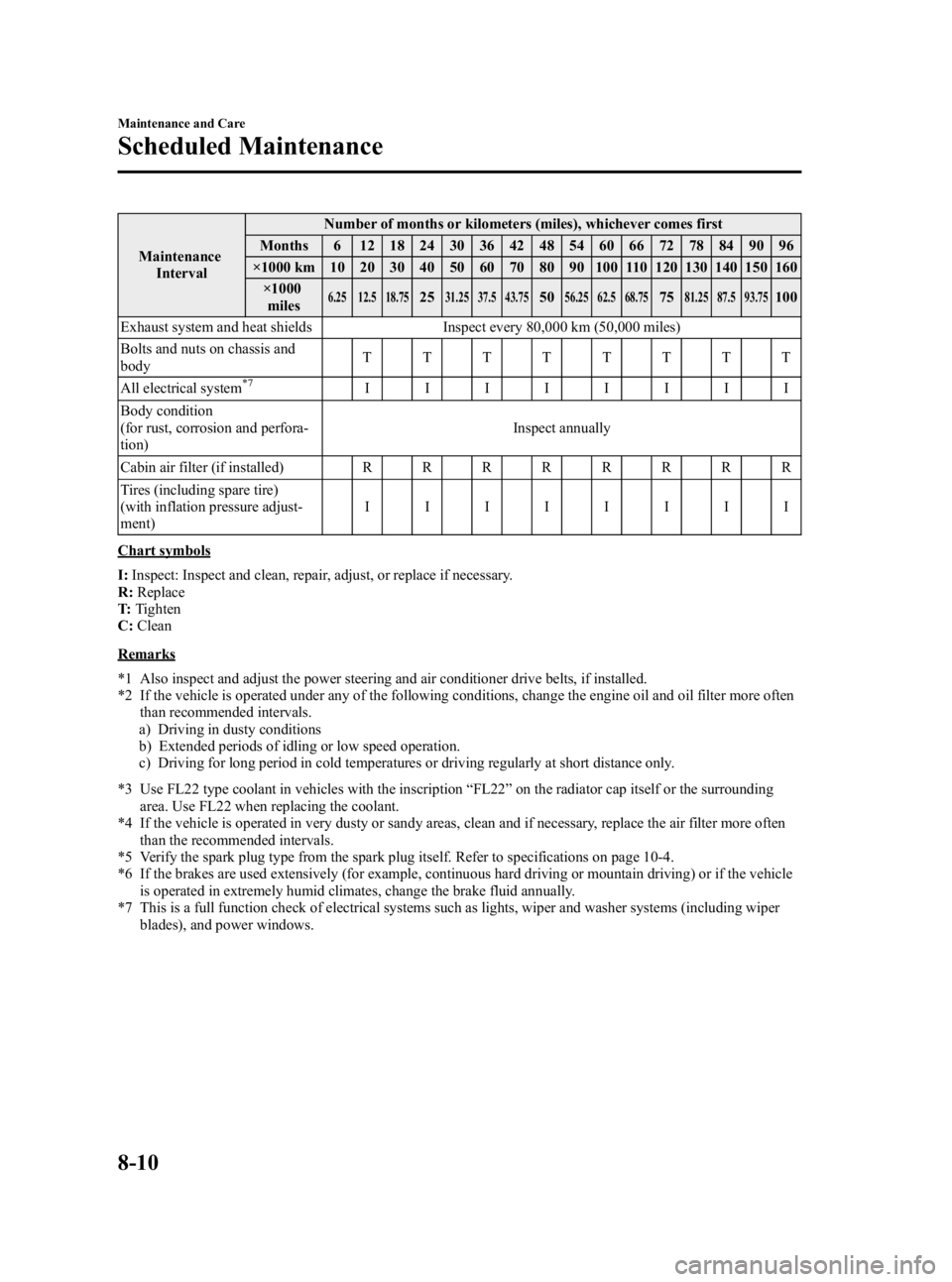
Black plate (252,1)
MaintenanceInterval Number of months or kilometers (miles), whichever comes first
Months 6 12 18 24 30 36 42 48 54 60 66 72 78 84 90 96
×1000 km 10 20 30 40 50 60 70 80 90 100 110 120 130 140 150 160 ×1000miles
6.25 12.5 18.752531.25 37.5 43.755056.25 62.5 68.757581.25 87.5 93.75100
Exhaust system and heat shields Inspect every 80,000 km (50,000 miles)
Bolts and nuts on chassis and
body TTTTTTTT
All electrical system
*7IIIIIIII
Body condition
(for rust, corrosion and perfora-
tion) Inspect annually
Cabin air filter (if installed) RRRRRRRR
Tires (including spare tire)
(with inflation pressure adjust-
ment) IIIIIIII
Chart symbols
I:
Inspect: Inspect and clean, repair, adjust, or replace if necessary.
R: Replace
T: Tighten
C: Clean
Remarks
*1 Also inspect and adjust the power steering and air conditioner drive belts, if installed.
*2 If the vehicle is operated under any of the following conditions, change the engine oil and oil filter more often
than recommended intervals.
a) Driving in dusty conditions
b) Extended periods of idling or low speed operation.
c) Driving for long period in cold temperatures or driving regularly at short distance only.
*3 Use FL22 type coolant in vehicles with the inscription “FL22 ”on the radiator cap itself or the surrounding
area. Use FL22 when replacing the coolant.
*4 If the vehicle is operated in very dusty or sandy areas, clean and if necessary, replace the air filter more often than the recommended intervals.
*5 Verify the spark plug type from the spark plug itself. Refer to specifications on page 10-4.
*6 If the brakes are used extensively (for example, continuous hard driving or mountain driving) or if the vehicle is operated in extremely humid climates, change the brake fluid annually.
*7 This is a full function check of electrical systems such as lights, wiper and washer systems (including wiper blades), and power windows.
8-10
Maintenance and Care
Scheduled Maintenance
Mazda3_8T96-EA-04J_Edition3 Page252
Wednesday, May 11 2005 3:39 PM
Form No.8T96-EA-04J
Page 259 of 378

Black plate (259,1)
Engine Coolant
qInspecting Coolant Level
WARNING
Hot Engine:
A hot engine is dangerous. If the
engine has been running, parts of the
engine compartment can become very
hot. You could be burned. Carefully
inspect the engine coolant in the
coolant reservoir, but do not open it.
Do not use a match or live flame in the
engine compartment. DO NOT ADD
COOLANT WHEN THE ENGINE IS
HOT.
Cooling Fan and Engine
Inspection:
Inspecting the engine with the ignition
switch in the ON position is
dangerous. The cooling fan could turn
on unexpectedly even when the engine
isn't running. You could be seriously
injured by the fan. Turn the ignition
switch off and remove the key from the
ignition switch when you inspect the
engine.
Cooling System Cap:
When the engine and radiator are hot,
scalding coolant and steam may shoot
out under pressure and cause serious
injury. Don't remove the cooling
system cap when the engine and
radiator are hot. Inspect the antifreeze protection and
coolant level in the coolant reservoir at
least once a year
―at the beginning of the
winter season ―and before traveling
where temperatures may drop below
freezing.
Inspect the condition and connections of
all cooling system and heater hoses.
Replace any that are swollen or
deteriorated.
The coolant should be at full in the
radiator and between the MAX and MIN
marks on the coolant reservoir when the
engine is cool.
If it's at or near MIN, add enough coolant
to the coolant reservoir to provide
freezing and corrosion protection and to
bring the level to MAX.
CAUTION
Radiator coolant will damage paint.
Rinse it off quickly if spilled.
If the coolant reservoir is empty or new
coolant is required frequently, consult an
Authorized Mazda Dealer.
Maintenance and Care
Owner Maintenance
8-17
Mazda3_8T96-EA-04J_Edition3 Page259
Wednesday, May 11 2005 3:39 PM
Form No.8T96-EA-04J
Page 261 of 378

Black plate (261,1)
To change coolant
WARNING
Removing the Cooling System Cap:
Removing the cooling system cap
while the engine is running or hot is
dangerous. This might lead to cooling
system and engine damage and could
result in serious injury from escaping
hot coolant or steam. Turn off the
engine and wait until it's cool. Even
then, be very careful when removing
the cap.
Wrap a thick cloth around the cap and
slowly turn it counterclockwise about
two and a half rotations.
Step back while the pressure escapes.
When you're sure all the pressure has
escaped, turn the cap
counterclockwise―still using a cloth
― and remove the cap.
1. Make sure the engine is not running and it has cooled.
2. Remove the cooling system cap.
Loosen
Loosen
Tighten
Tighten
3. Remove the radiator drain plug and
drain the coolant into a suitable
container. Properly dispose of the used
coolant. 4. Flush out the system with running
water.
5. Drain the system completely. Insert and tighten the plug. Add as much
ethylene-glycol-based coolant mixture
and water as necessary to provide
freezing and corrosion protection.
6. In extremely cold climates, add the mixture percentage recommended in
the coolant mixture percentage table.
7. Run the engine at idle with the cooling system cap off. Slowly add additional
coolant if necessary.
8. At this point, wait until the engine reaches normal operating temperature;
then depress the accelerator two or
three times. Add more coolant, if
necessary, until the system is full.
9. Install the cooling system cap. Inspect all connections for leaks. Inspect the
level in the coolant reservoir one more
time and verify that the coolant level is
between the F and L marks.
Maintenance and Care
Owner Maintenance
8-19
Mazda3_8T96-EA-04J_Edition3 Page261
Wednesday, May 11 2005 3:39 PM
Form No.8T96-EA-04J
Page 265 of 378

Black plate (265,1)
Washer Fluid
qInspecting Washer Fluid Level
WARNING
Substitute Washer Fluid:
Using radiator antifreeze as washer
fluid is dangerous. If sprayed on the
windshield, it will dirty the windshield,
affect your visibility, and could result
in an accident. Use only windshield
washer fluid or plain water in the
reservoir.
Using Washer Fluid Without Anti-
freeze Protection in Cold Weather:
Operating your vehicle in
temperatures below 4 degrees C (40
degrees F) using washer fluid without
anti-freeze protection is dangerous as
it could cause impaired windshield
vision and result in an accident. In
cold weather, always use washer fluid
with anti-freeze protection.
NOTE
State or local regulations may restrict
the use of volatile organic compounds
(VOCs), which are commonly used as
anti-freeze agents in washer fluid. A
washer fluid with limited VOC content
should be used only if it provides
adequate freeze resistance for all
regions and climates in which the
vehicle will be operated. Inspect fluid level in the washer fluid
reservoir; add fluid if necessary.
To inspect the washer fluid level in the
front reservoir, pull off the cap. Then,
holding your thumb over the hole in the
center of the cap, lift it straight up. The
fluid level can be seen from the fluid
column in the pipe. Add fluid if necessary.
Use plain water if washer fluid is
unavailable. But use only washer fluid in
cold weather to prevent it from freezing.
NOTE
Front and rear washer fluid is supplied
from the same reservoir.
Maintenance and Care
Owner Maintenance
8-23
Mazda3_8T96-EA-04J_Edition3 Page265
Wednesday, May 11 2005 3:39 PM
Form No.8T96-EA-04J